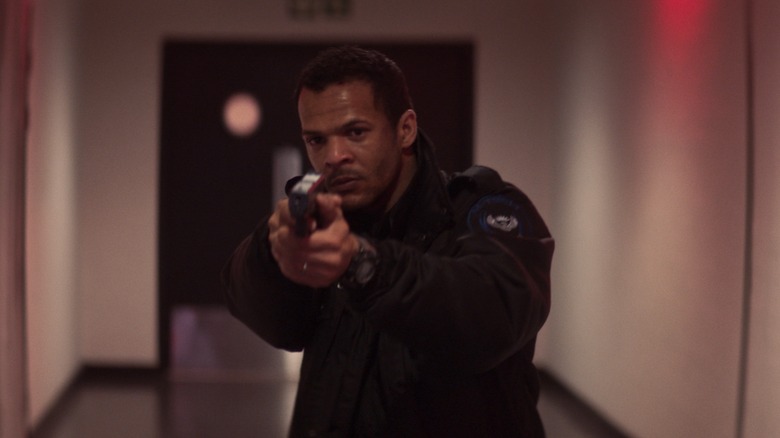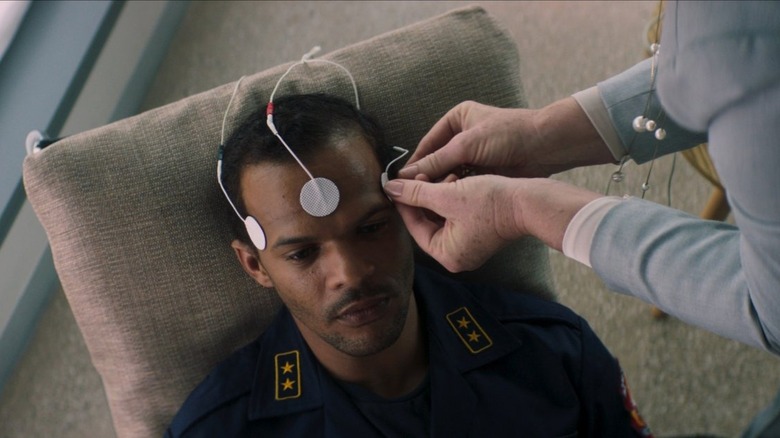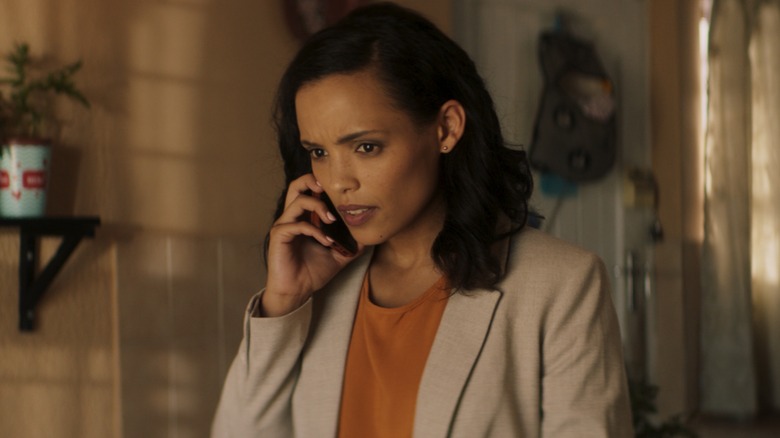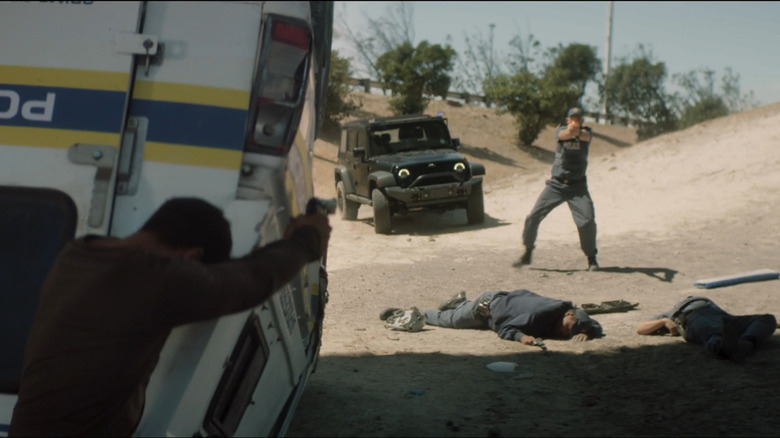Indemnity Director Travis Taute On Staging Fistfights And Car Crashes With Limitations [Interview]
Producer Travis Taute always knew that when he'd make his directorial debut, it would be an action movie. Taute's thriller, "Indemnity," takes a grounded approach. With the power of limitations, Taute, his team, and his star, Jarrid Geduld, make their action pack a little more punch with practically, plausibility, and a general lack of CGI. As Taute explained, it wasn't always easy, but the challenge is exciting.
Prior to making his conspiracy thriller dealing with PTSD, Taute has been producing films and shows for Gambit Films. Based in Cape Town, South Africa, the production company is behind "Blood & Water" and "Number 37." Recently, Taute told us about his experiences at Gambit Films, as well as how to pull off car crashes, fistfights, and gunfights with limitations.
'How do we create that?'
Gambit Films, what does a weekday like today look like for the production company?
Today, we are about to start shooting a third season of a show for Netflix, which I think is coming out later this year. We are about two weeks away from actually starting production. So today was literally a cast read-through, which is the first time we got the cast together to actually go through all of the scripts, which is pretty exciting. But essentially it's that two-week window before going into production. It's bloody chaos, like scrambling to have the last things fall into place. And that always happens literally hours, if not a few days before the time. It's that super, highly stressful time at the moment, but I also love it. I can't really complain.
What usually goes wrong two weeks before production starts?
I find it's usually locations and working within the parameters of a budget. So we have a limited budget, but the scope of the show is quite ambitious. There's a lot of compromising and shifting and shaping. I think of it as this giant balloon. And the moment you poke in the one side, then something pokes at the other side, you have to keep the whole thing together like that.
If it is not a location that is potentially falling through, location owners suddenly come back because Cape Town's film savvy. We have a ton of s**t happening here quite often. So people just see an opportunity and they're like, "Ooh, money." And then they charge these exorbitant fees for what would otherwise be just an ordinary location. And so, oftentimes if we are there for a couple of days, we realize that, "S**t, we can't really afford to be there."
So we're two weeks away, but we have to find another location and then dress the location and get it prepped. To me, that is a biggie. In between location and all the prep that needs to be done, it's just finding the time to rehearse and getting to a space where you are stepping onto sets and actually being in full control of where things are headed, because we have quite a large cast, quite a young cast. And our shooting pace is ridiculous. So to get everyone to really come on day one, there isn't time to still find your feet. You hit the ground running and you have to go for it. So it's being able to be ready for that and deal with every single problem that usually comes our way.
As you said, sometimes you'll want a location and the cost will go way up. And I imagine sometimes it's because of these bigger productions from the US coming in.
Yeah, absolutely.
Of course, that provides jobs, but does it hurt local filmmakers?
It's really interesting. I think South Africa incentivizes a lot of international productions to come here because we offer a really amazing tax rebate through our department of trade and industry. Most of those international shoots come to Cape Town versus shooting in Johannesburg, which is another big city up north two hours away. It's a lot cheaper to shoot there in terms of locations, equipment. Everything else it's accommodation, if you're hosting crew and cast and there are other elements that aren't necessarily on screen that become cheaper to produce. For Capetonians, and this is part of the problem that we are experiencing at the moment is that with all this influx of productions, you have American money and there's a limited amount of locations.
There's a limited amount of gear. There's a limited amount of crew available in terms of the city. There's a lot of them, but there is a limit with the amount of productions that are ongoing at the moment. It becomes difficult to secure the kind of talent, crew-wise, that you would want to have on a project because they're being offered a rate that you really can't compete with. The same thing is happening with regards to locations where someone is like, "I need 50K a day." You only have 20K. And at any other time in the year, it would be acceptable for that person to accept 20K. But right now it's like, okay, well with all these productions going on, they're like, "Well, if you're not going to pay me this, there's someone else waiting in line to pay that 50K."
It becomes a challenge on various fronts. I would say there isn't one specific area that makes it quite difficult. I think holistically, it just becomes quite challenging because usually, the kinds of budgets that we're dealing with are infinitely smaller than the money that is coming from overseas productions.
With "Indemnity," you're making a fairly universal action movie.
That was the intention, just a really entertaining film.
Compared to other projects you've worked on, how did its obvious commercial appeal help in financing and securing certain resources?
We knew from the get-go that it was a very, very ambitious project, and thinking about African box office, there's a particular kind of film that usually gets made here that sees a return on investment. And there's usually a budget level in terms of the average spend on a film made in South Africa, which is why you are used to seeing a particular kind of film coming from South Africa. It's more of a drama or potentially a horror, whereas action is notoriously expensive to produce. And so for us, it was considering, okay, what possible returns we could expect locally, but then realizing that actually, we want the film to travel. We want to make a film that's universally relatable. What are those genre elements that people would go to regardless of where the film is set?
In the design of the story and the various set pieces, it was made with that intention and with that in mind. But knowing full well that we wouldn't be able to achieve the kind of scale you see in Hollywood nor any other Marvel film. So what we actually did was go, "Okay, cool. This is our budget, and these are all the key action sequences throughout the film."
Based on the format of the genre that we're used to seeing, if you want to call it an action film, there needs to be a sequence like every 10 minutes. It was identifying what those were going to be and instead of casting each of those and then going, "Well, what are various ways we could bring that down? And how could we be clever in our design to make it achievable with the limited budget that we have?" Which is why a lot of the fight sequences were quite contained to an elevator or to the back of a police van.
We identify these pillars in the film that would be "This is where we'd spend some money." So that sequence at the end, we want to have as much practical fire down that corridor as possible, so how do we create that? And how can we have interactive elements for our character to move through so that becomes hyper-realistic? And so, it was being very selective of which stunts were going to be the ones that we were going to pool money behind and then try to pull back on certain other ones and go, "Well, how can we be smart about trying to create an exciting set-piece without necessarily throwing too much money at it." Which is why there's a lot of hand-to-hand combat as well, [and] is why it felt like that was feasible for the film that it also made sense for the character and the story, which is awesome.
'Instead of the vehicle actually rolling down the hill, it just went like boop'
We're now used to seeing a hero fight a horde of goons, but really, one is all you need. It's difficult enough.
100%. I love those films that do that as well, where it is smaller in scope, and it's a bit more tense and it's a bit more personal. I knew that with this film, it was like my love letter to the action films made in the '90s, where you had these action films that were awesome genre pieces. But they were character-driven.
I really wanted to make a film that had a heart that was driven by a character. A story about this man who has this trauma and then weaves in the action sequences to his emotional journey. And so it also felt organic and right to have the experiences that he was having in terms of the action set pieces, be it something very close and intimate and physical. He is facing real danger up close versus trying to create spectacle on a scale we just wouldn't pull off properly.
You don't put the camera close-up during those fights. There's space.
Yeah, that was definitely a conscious choice. I personally just love films where you're letting the camera be, and you're seeing everything play out on screen in a very organic way. And trying, whenever possible, not to intercut too much and feel like you're cheating the audience or speeding things up. In our preparation for this film, I knew that I wanted to do everything wherever possible, as practical as possible. Because one of the ... things that I don't enjoy about filmmaking is sometimes there's just that one VFX shot that isn't done 100% properly. It just pulls you out of the moment. I wanted the movie to feel hyperreal. I wanted us to fear for Theo as he's going through this experience.
A good old-fashioned elevator fight scene is always welcomed. With a space that contained, what are the technical challenges?
We realized before we had started shooting that we actually had too much to shoot in the amount of days that we had to actually pull off the film. We had been rehearsing this fight for a really long time. We wanted to do a test shoot just to prepare for our actual first principal photography, and it was only supposed to be like two, three hours. And we had this set built, we had the elevator. Basically, each wall of the elevator was built. And so every time we needed to film from a particular angle, we would just remove one door and shoot from that particular angle. Whether it be aerial view or either side or front-on view.
We did our test shoot that day, and it evolved into an entire day of shooting because I think everyone was so excited. It was our first foray into action, a lot of us. We were still finding our groove and we knew what style we wanted to go with, but it was awesome seeing it come to life in that environment. It was super challenging. It really was. It took ages. I think what equated to a minute on screen took a pretty damn long time to actually film. I think we must have spent a full day, if not a little bit longer just trying to achieve that scene.
Was it a similar approach to the action scene where he's handcuffed in the car?
Yeah, absolutely similar approach. I think the car sequence was a little bit harder. I knew that he had to be traveling on a freeway, but I also knew that we would never be able to close off a freeway. We had to figure out how to combine certain elements of the sequence, but not shoot them all as authentically as we would've hoped.
We had the actual car crash, which we filmed, which was the exterior shot where you actually see the car coming down the embankment. Which was also very interesting because we literally had one police vehicle. I remember everyone coming on to set that day because we had been talking about the stunt for such a long time.
Everyone was so excited and we had planned it for weeks and weeks and weeks. Using little toy cars, this is how it was going to go. We got to set that morning and it was so windy. We had gale force winds going on. After a couple of rehearsals, [with] the vehicle moving back and forth, and us setting up our shots, we eventually went for this one take, because we only had one vehicle. And then as it comes down, it hits this bank of sand and it kills the trajectory of the car.
Instead of the vehicle actually rolling down the hill, it just went like boop and fell back down. It was so anticlimactic that everyone was like, "No." I just remember everyone, myself included, being so bummed that morning and going like "S**t, f**k. What can we do?" It was what it was.
We found clever ways and cheated. So that was the one part, the exterior. And the other part was we actually had to build the back of the police van. Basically, our art director replicated what the back of the police van looked like. And then we had to attach that to a gimbal, which we then shot in the studio. We did all the interior fight scenes in the studio with a green screen, then shot the plates, the moving plates of the vehicles moving past, along the freeway separately.
And then, I had that moment where we had special effects guys on either side of, the kind of indie filmmaking where basically it has to look like a car moving. People are shaking the vehicle from either side. We had to do the flip and we had these four burly men going, "Okay, cool. One, two, three," and flipping the whole thing over. And that was it and then we just stitched all of the components together.
It's funny hearing your experience shooting that car cash. Usually, cars just tumble over and over in movies, but that sounds and plays more realistic.
Exactly. It was an experience, but it was awesome. Doing all these stunts was such an awesome learning experience. I always wanted to play in this genre and I really love action. Going through these experiences, just to be able to learn and understand what it takes from a safety perspective, from a stunt perspective, it's incredible because there are so many things you don't think of. I'm just like, "Well, just go and sit and let's just do it and let's just see what happens." Not how it works.
'I can't imagine it would be easy, but that's what's exciting'
From a safety perspective, what did you learn from watching all the stunts prepped and performed?
The big takeaway is it takes a long time to get all the right safety precautions in place. What I appreciated about it was the fact that we had such an incredible stunt team and guys who are super experienced that worked in multiple productions that are shot in South Africa, "Tomb Raider," "Mad Max” kind of thing. They've never necessarily worked on a local film. So obviously working on those kinds of big projects, they have access to a serious amount of equipment and scopes. We had to achieve the same thing and the same stunts on less. But you could never negate or make any shortcuts when it came to safety, because we were doing very dangerous stunts. The stunt, in which Jarrid was hanging out of the 22nd floor of a window, was literally Jarrid hanging out of a window. He had various safety harnesses attached to him.
For different parts of that stunt, he had different kinds of safety harnesses on. Sometimes it was two attached to his back, or one just in front, depending on where we wanted the camera to be. What I find really interesting is the policemen who were inside the hotel who just, even if they were going to the open window, all had to be rigged inside the hotel and had these safety harnesses attached to them. So things like that, [things] you don't really think of, of course that makes complete sense because that's from a safety perspective, but you don't necessarily think about all those things.
With the fire sequences, which I thought would actually be bigger, that crew was pretty freaking amazing. In the opening shack fire, we pretty much lit almost everything in that shack on fire, including one of the stuntmen ... that was completely him [burning]. And so for that sequence, which I thought was very challenging, we actually bought this container. For that opening sequence, no one could be in there except the DOP because there was no space for anyone else. [The DOP] had to have his gas mask on because the smoke was so intense. There were just so many elements at play at any given time. And when there is a burn being done, you can only shoot for 45 seconds before we have to cut and we have to get safety crews in there to make sure everyone is okay.
Given all these lessons, what do you hope to achieve with your next action movie?
The next action film — I'm working on one at the moment that actually — just has a lot more action in it. The film that I'm working on, it's nonstop. So where "Indemnity" had breaks and we had little breathers, this new one is an assault of intense action. The characters and story intrigue me, but I think having that amount of action could very easily just become meaningless and be not sustainable over an extended period of time. I think audiences can very quickly get exhausted as well.
My intention is to find a way to have things evolve stylistically, so that you're always feeling [that] every new sequence feels fresh and influenced by a different genre and experience. It's quite contained, though. It takes place in a single location, but what happens in the location is going to be a lot more interesting. I think the film itself naturally lends itself to more design where my ambition is to create this one-take sequence, which at the moment, it's scripted as 15 pages, which is super ambitious. We'll see. I don't know. I'm putting it out there so that I get held to it and then I just hash it back and pull it off. So that's the ambition.
Best of luck with it. That won't be easy.
I can't imagine it would be easy, but that's what's exciting. I think this industry is so amazing in that you get to try things, hopefully you don't fail all the time, although failure's not the worst thing. You only learn from failure. But we do get to play around and do some cool, fun things. Hopefully, people find it interesting and entertaining and that's what you can hope for.
"Indemnity" is now available on VOD.



